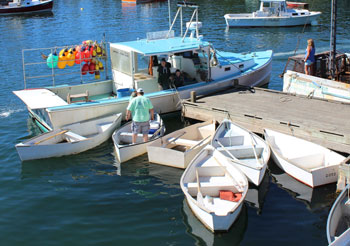Punt
(as in a Maine Fishermen’s)
by Lee S. Wilbur

“You know, Lee, I’m thinking...of course if Jane will let me...about buying a “punt.” There’s a fellow going into Southwest, you may know him. Usually has one on his front yard. I’m thinking he must build them. What do you think of my idea?”
Don and Jane Seabury had been summer neighbors of ours on the pond for many years and we’d become great friends. They were from Southhampton, Long island, New York, and Don, throughout his working life, as well as being a talented machinist, had spent a goodly amount of time on the water both for pleasure and commercially. I know that spending the summer on a beautiful lake/pond such as ours and away from heat was great for the Seaburys, but Don needed something to occupy his time. Couple of summers he worked for me at the boatshop doing some varnish and painting just for something to do and I suspect for the camaraderie of our crew as well.
I encouraged him to “yes, by all means buy a punt, a rowboat,” anything to get some exercise. Jane walked every day and sometimes twice.

A variety of Maine punts tied up at the Winter Harbor Town Wharf. Far right “GORS” on the transom is a close approximation of the classic lines of the “Maine punt.” Near center foreground double ender with a notch in the transom for sculling. Two gents standing in a version that references the lines of a Maine pea pod and to their right a thin fiberglass shell version of the first. Fishermen’s Voice photo.
For practically anyone who has lived along the coast of Maine for any stretch of time, a “punt” may cover a wide range of rowing craft that fishermen and others use to get out to his boat, (and within the last 30 years, perhaps “her” fishboat). Drop into any cove or harbor along Maine’s multi-thousand mile-plus coast and you will be bound to find a float or beach with rowboats tied or pulled up waiting to be rowed to a mooring for the day while it’s owner chases lobsters or clams or another endeavor upon the water.
Not only are these “punts” of many shapes and sizes, but often not in the best of repair, sole purpose being two ten minute “to and from” trips a day to one’s workboat. However, there is one style, the true Maine “Punt” that to my mind stands out from all others both for it’s looks and for it’s safety. May not be the easiest of the group to row but surely the safest when crawling up over the side of a rolling Downeast lobsterboat, in howling wind and sun still working on plans to rise. A fisherman can row sitting, or stand and row facing forward, or as a few I’ve seen, do a standing scull to and from the mooring.
Don was a fairly hefty guy. Getting a bit long in years. Arthritis had begun to plague him as it does pretty much all of us in our late calendar years. He’d added a few inches to his “belt and pants” wardrobe and unlike Jane didn’t enjoy mountain hikes or flat walks for that matter. Secondly, whoever had built their dock had designed it for “ice-out” in spring and by summer three or four rungs on the ladder were dry. Don was not going to have an easy or too safe “in and out” and I realized one reason he’d been hesitant to buy a punt or any other rowing craft was Jane’s concern with his falling.
The true Maine “Punt”
to my mind stands out
from all others.
Don and I would nudge the subject for a few years. Always ask me what I thought. I’d encourage him. Think to myself “he needs to make up his mind soon or never will be able to handle the ladder” Finally, big grin on his face, he comes over one afternoon and announced that he’s put his order in with Steve Spurling for the next year and what I remember as an 11-12 foot, cedar planked, Punt. Unpainted.
Following summer, I swear, Don and Jane arrived early. Weren’t here a day but what I spied one of Steve’s gorgeous unfinished, except for a coat of white primer, Maine Punts set up on two sawhorses Don had built especially for his new project. He looked 10 years younger and ready to go rowing as soon as he’d painted it with two coats of “Marine White.”
Week’s end, new pair of unpainted oars, red boat cushion for safety, split of champagne splashed over the bow, Don, with neighbor’s help, carefully set his dream punt into the water. Later that day a launching party was in order when neighbors enthusiastically gathered to toast many happy miles.
Don was ecstatic. And, so was Jane. And, so was I. I’ve loved boats ever since I was a kid. I’ve thought for some time Jarvis Newman did the Coast of Maine a great favor when he did a fiberglass knockoff of the Islesford/Cranberry Island “Spurling Dinghy” for it’s great lines. Have to say that my old mentor Jim Willis was right when he described the “new” style boats back in the 70s. “Looked like someone had spilled baby food “Pablum” on a drawing board and tried to connect a few lines.” Luckily there are still some Maine boatbuilders and designers existing who understand the term “Shear”. “Tumblehome” though seems to have passed into design history.
Jarvis Newman did the
Coast of Maine a great
favor when he did
a
fiberglass knockoff of the Islesford/Cranberry Island “Spurling Dinghy”
Don, in his “nineties” passed away this past year. And, as I’m prone to do when Mr. Crowe is checking his computer, looking for my scribblings of the month and 3am becomes a “new subject wrestling match” I thought I might do this article about Don and his punt. Thought I might also explore a bit regarding the term “Punt” and whether our style of Punt is found upon other waters. So “Wikipedia,” that repository of virtually every word definition on earth came to mind. At first light I looked it up. Only definition of “Punt” as a water craft is a “flat bottomed boat with a square cut bow (or ends)” mainly for use on rivers and streams. Reference was also made to British Isles waterways and canals and delta areas where “punts”were generally sculled. Needless to say I was dis-appointed to learn our Maine style was missing.
I’d like to introduce one of Steve’s type of punt to Florida. Unfortunately, warm humid weather and “worm infested water” would be an unkindly gesture and a fiberglass “punt” is not in my vocabulary.
• R E C I P E •
Ben’s Best Cornbread
1 cup plain yellow cornmeal
1 cup all-purpose flour
1 T. baking powder
1 t. kosher salt
¼ t. baking soda
2 cups buttermilk
2 large eggs
½ cup butter
Preheat oven to 425 deg. Whisk together first 5 ingredients in a large bowl. Whisk in a seperate bowl the buttermilk and eggs. Stir into cornmeal mixture until just combined. Heat a 10 inch cast iron skillet over medium heat until it just begins to smoke. Add butter and stir until butter is just melted. Stir melted butter into cornbread batter. Pour batter into hot skillet and bake at 425deg. For 25-30 minutes or until golden and cornbread pulls away from sides of skillet. Invert cornbread onto a wire rack; Serve warm with any condiments you can think of...maple syrup...molasses...strawberry jam...apple jelly....more butter!! Wicked Good!!!
Fair Winds and Good Fishing
– Lee Wilbur
